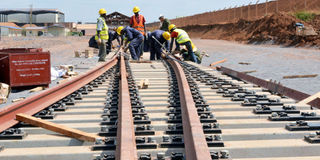Why Tanzania, Kenya and Uganda are falling back to old railway

What you need to know:
Tanzania’s recent move mirrors Kenya’s and Uganda’s, both of whom have announced plans to revamp their old lines amid uncertainty over the progress of the joint SGR line on the Northern Corridor, due to lack of funding
As Tanzania continues with the construction of the standard gauge railway, the government has also embarked on revamping the old metre gauge railway network built by colonialists over a century ago.
The programme is aimed at facilitating the transporting goods to EAC neighbours to and from Dar es Salaam and Tanga ports.
Transport
Tanzania’s recent move mirrors Kenya’s and Uganda’s, both of whom have announced plans to revamp their old lines amid uncertainty over the progress of the joint SGR line on the Northern Corridor, due to lack of funding.
Tanzania Railway Corporation’s managing director Masanja Kadogosa said the renovation would end years of neglect.
Phase one of the programme, which started in early 2018 of the northern railway network from Tanga port to Moshi railway station, covering 353km, is complete. It was fully funded by the government at Sh5.7 billion ($2.1 million).
A section of the line connects to Kenya at the junction of Kahe railway station with a branch passing through Taveta border and connecting to the Mombasa-Kampala line at Voi in Taveta hills in Kenya.
The line has been out of commission for years from neglect and lack of funding, which resulted in the cargo trains suspending services since 1994.
The move has exacerbated the high charges incurred by transporters using trucks to haul export and import goods through Tanga port.
The cost to be incurred by the whole programme is estimated at Tsh14 billion ($6.8 million), which would include the purchase of wagons and locomotives.
Last week, Prime Minister Kassim Majaliwa witnessed a grand inauguration ceremony of the new 20 wagons that carried 800 tonnes of cement from Tanga to Moshi.
Multibillion shilling
Analysts say that, these would be carried by 30 trucks at a higher cost.
Operations between the two towns and an extension railway line to Arusha city reduced gradually before shutting down transportation of goods and passengers over a decade ago.
This was blamed on a drying up of funding and compounded by poor management.
Over three weeks ago, Tanzanians witnessed a grand testing ceremony of the first Standard Gauge Railway locomotive to be used by the engineers currently supervising the quality of work along the newly spread track.
The SGR project contractor Turkish firm Yapi Merkezi, in partnership with Portuguese firm Mota-Engil Africa, allowed the locomotive, which was used for testing along 20-km stretch of track from Soga station in Kibaha District, towards Morogoro.
It will ferry engineers along an estimated of 150km between Dar es Salaam and Morogoro as they complete the multi-billion shilling project.
The Minister for Works, Transport and Communication, Isaack Kamwelwe, said the government has started the process of purchasing 22 locomotive engines for passenger wagons, 1,430 cargo wagons and 60 passenger wagons to be used for operations once the first section is complete by December this year.
Plan B
Kenya, which had planned to launch the second phase of its SGR between Nairobi and Naivasha in August, suffered a setback after failing to secure funding from China.
Kenya will now revamp its metre-gauge railway to Malaba, after securing a $400 million loan from China. This puts the brakes on Uganda’s hopes of getting a modern railway to transit its goods through Kenya.
Cargo will now reach Naivasha, get evacuated by trucks to the new metre gauge before eventually moving to Malaba and onwards to Kampala and beyond.
Uganda is already upgrading its metre gauge railway line from Malaba to Kampala at a cost of $170 million. The country plans to upgrade two lines, Malaba-Kampala and Tororo-Gulu.




